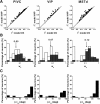A comparison of vestibular spatiotemporal tuning in macaque parietoinsular vestibular cortex, ventral intraparietal area, and medial superior temporal area
- PMID: 21414929
- PMCID: PMC3062513
- DOI: 10.1523/JNEUROSCI.4476-10.2011
A comparison of vestibular spatiotemporal tuning in macaque parietoinsular vestibular cortex, ventral intraparietal area, and medial superior temporal area
Abstract
Vestibular responses have been reported in the parietoinsular vestibular cortex (PIVC), the ventral intraparietal area (VIP), and the dorsal medial superior temporal area (MSTd) of macaques. However, differences between areas remain largely unknown, and it is not clear whether there is a hierarchy in cortical vestibular processing. We examine the spatiotemporal characteristics of macaque vestibular responses to translational motion stimuli using both empirical and model-based analyses. Temporal dynamics of direction selectivity were similar across areas, although there was a gradual shift in the time of peak directional tuning, with responses in MSTd typically being delayed by 100-150 ms relative to responses in PIVC (VIP was intermediate). Responses as a function of both stimulus direction and time were fit with a spatiotemporal model consisting of separable spatial and temporal response profiles. Temporal responses were characterized by a Gaussian function of velocity, a weighted sum of velocity and acceleration, or a weighted sum of velocity, acceleration, and position. Velocity and acceleration components contributed most to response dynamics, with a gradual shift from acceleration dominance in PIVC to velocity dominance in MSTd. The position component contributed little to temporal responses overall, but was substantially larger in MSTd than PIVC or VIP. The overall temporal delay in model fits also increased substantially from PIVC to VIP to MSTd. This gradual transformation of temporal responses suggests a hierarchy in cortical vestibular processing, with PIVC being most proximal to the vestibular periphery and MSTd being most distal.
Figures











Similar articles
-
Evidence for a Causal Contribution of Macaque Vestibular, But Not Intraparietal, Cortex to Heading Perception.J Neurosci. 2016 Mar 30;36(13):3789-98. doi: 10.1523/JNEUROSCI.2485-15.2016. J Neurosci. 2016. PMID: 27030763 Free PMC article.
-
Representation of vestibular and visual cues to self-motion in ventral intraparietal cortex.J Neurosci. 2011 Aug 17;31(33):12036-52. doi: 10.1523/JNEUROSCI.0395-11.2011. J Neurosci. 2011. PMID: 21849564 Free PMC article.
-
Dynamics of Heading and Choice-Related Signals in the Parieto-Insular Vestibular Cortex of Macaque Monkeys.J Neurosci. 2021 Apr 7;41(14):3254-3265. doi: 10.1523/JNEUROSCI.2275-20.2021. Epub 2021 Feb 23. J Neurosci. 2021. PMID: 33622780 Free PMC article.
-
The parieto-insular vestibular cortex in humans: more than a single area?J Neurophysiol. 2018 Sep 1;120(3):1438-1450. doi: 10.1152/jn.00907.2017. Epub 2018 Jul 11. J Neurophysiol. 2018. PMID: 29995604 Review.
-
The vestibular cortex. Its locations, functions, and disorders.Ann N Y Acad Sci. 1999 May 28;871:293-312. doi: 10.1111/j.1749-6632.1999.tb09193.x. Ann N Y Acad Sci. 1999. PMID: 10372080 Review.
Cited by
-
Decentralized Neural Circuits of Multisensory Information Integration in the Brain.Adv Exp Med Biol. 2024;1437:1-21. doi: 10.1007/978-981-99-7611-9_1. Adv Exp Med Biol. 2024. PMID: 38270850
-
Self-motion perception and sequential decision-making: where are we heading?Philos Trans R Soc Lond B Biol Sci. 2023 Sep 25;378(1886):20220333. doi: 10.1098/rstb.2022.0333. Epub 2023 Aug 7. Philos Trans R Soc Lond B Biol Sci. 2023. PMID: 37545301 Free PMC article. Review.
-
Decentralized Multisensory Information Integration in Neural Systems.J Neurosci. 2016 Jan 13;36(2):532-47. doi: 10.1523/JNEUROSCI.0578-15.2016. J Neurosci. 2016. PMID: 26758843 Free PMC article.
-
Convergence of vestibular and visual self-motion signals in an area of the posterior sylvian fissure.J Neurosci. 2011 Aug 10;31(32):11617-27. doi: 10.1523/JNEUROSCI.1266-11.2011. J Neurosci. 2011. PMID: 21832191 Free PMC article.
-
Temporal and spatial properties of vestibular signals for perception of self-motion.Front Neurol. 2023 Sep 13;14:1266513. doi: 10.3389/fneur.2023.1266513. eCollection 2023. Front Neurol. 2023. PMID: 37780704 Free PMC article. Review.
References
-
- Adams MM, Hof PR, Gattass R, Webster MJ, Ungerleider LG. Visual cortical projections and chemoarchitecture of macaque monkey pulvinar. J Comp Neurol. 2000;419:377–393. - PubMed
-
- Akaike H. [Data analysis by statistical models] No To Hattatsu. 1992;24:127–133. - PubMed
-
- Akbarian S, Grüsser OJ, Guldin WO. Thalamic connections of the vestibular cortical fields in the squirrel monkey (Saimiri sciureus) J Comp Neurol. 1992;326:423–441. - PubMed
-
- Angelaki DE, Dickman JD. Spatiotemporal processing of linear acceleration: primary afferent and central vestibular neuron responses. J Neurophysiol. 2000;84:2113–2132. - PubMed
Publication types
MeSH terms
Grants and funding
LinkOut - more resources
Full Text Sources
